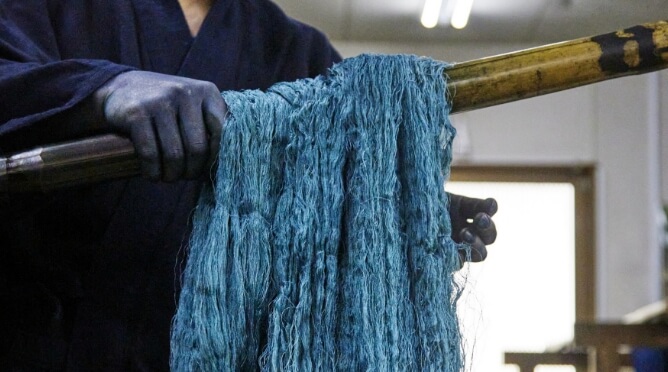Maintaining the best conditions for indigo
“Indigo lives and breathes”. Due to the fermentation process, the colour is drawn out due to oxidation. Even after the textile product is completed, the colour continues to change and become richer over the following 10 or even 20 years.
No two aizome pieces are the same. The result of each piece is dependent on many factors such as the natural dye itself produced in any given year, the day the piece was dyed, and how the finished piece is looked after. We take a lot of pride in our products in which our artisans have utilised their honed skills and senses to breathe life into their creations.
-

Pre-production process
The first crucial step is controlling the conditions for the process. Before placing the raw dye into the indigo earthenware pot, impurities are washed off and placed under running water for more than three hours.
-

Hand-washing
Whilst the fabric is washed for several hours under running water, the artisan must keep an attentive eye on it, checking the colouration quality throughout, which is also affected by the oxygen in the water, producing different gradations.
-

Post-production process
To maintain the best condition of the indigo dye, excess is drawn off and supplementary dye is created to make up for any drop in colour or dye strength. This is an important process that is carried out depending on the fabric to be dyed.
-

Hand-dyeing
Each piece is dyed by hand, one-by-one. The vast years of experience gained are essential to understanding the adjustments required for each dye and creation. The fabric is tightly wrung out to ensure the dye fully penetrates the fabric, strengthening the colouration.
-

Drying
After days of dyeing and drying, the colour is set into the fibres. As the indigo penetrates deeply into the fibres, its durability is strengthened. The artisan places his full commitment into this process which cannot be rushed.
-

Finishing up
The reason why indigo is said to be living and breathing is that after the fabric has been dyed, as time goes by, the texture of the fabric changes. The beauty and allure of aizome are evident, and for those who make lifelong use of it in their lives, it will bring with it a sense of added colour.








